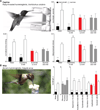Sensory biology. Evolution of sweet taste perception in hummingbirds by transformation of the ancestral umami receptor
- PMID: 25146290
- PMCID: PMC4302410
- DOI: 10.1126/science.1255097
Sensory biology. Evolution of sweet taste perception in hummingbirds by transformation of the ancestral umami receptor
Abstract
Sensory systems define an animal's capacity for perception and can evolve to promote survival in new environmental niches. We have uncovered a noncanonical mechanism for sweet taste perception that evolved in hummingbirds since their divergence from insectivorous swifts, their closest relatives. We observed the widespread absence in birds of an essential subunit (T1R2) of the only known vertebrate sweet receptor, raising questions about how specialized nectar feeders such as hummingbirds sense sugars. Receptor expression studies revealed that the ancestral umami receptor (the T1R1-T1R3 heterodimer) was repurposed in hummingbirds to function as a carbohydrate receptor. Furthermore, the molecular recognition properties of T1R1-T1R3 guided taste behavior in captive and wild hummingbirds. We propose that changing taste receptor function enabled hummingbirds to perceive and use nectar, facilitating the massive radiation of hummingbird species.
Copyright © 2014, American Association for the Advancement of Science.
Figures




Comment in
-
Evolution. Sensing nectar's sweetness.Science. 2014 Aug 22;345(6199):878-9. doi: 10.1126/science.1259175. Science. 2014. PMID: 25146273 No abstract available.
References
-
- Nei M, Niimura Y, Nozawa M. Nat. Rev. Genet. 2008;9:951–963. - PubMed
Publication types
MeSH terms
Substances
Grants and funding
LinkOut - more resources
Full Text Sources
Other Literature Sources
Medical

